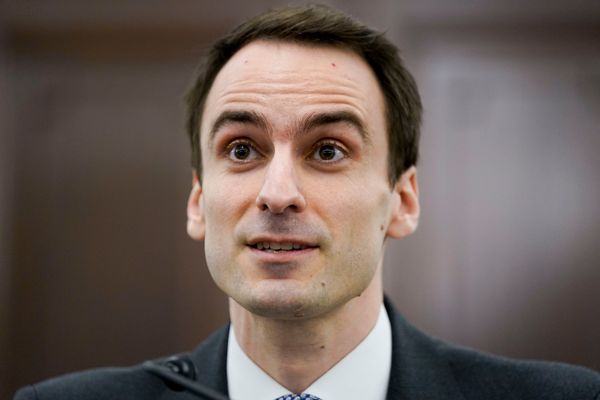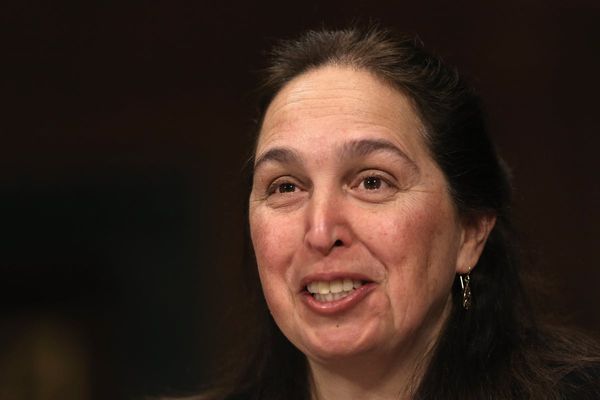
The Coalition’s nuclear energy plan creates “a significant risk” for the stability of the nation’s grid, according to the peak body representing power generators and retailers.
Responding to the Friday release of modelling by Frontier Economics of the Coalition’s scheme to build seven nuclear power plants from the mid-2030s, the Australian Energy Council warned the estimates assumed a slower build out of renewable energy.
The council’s chief executive, Louisa Kinnear, said they were “particularly concerned about the assumed lack of investment in new and replacement generation over the next 10 years”.
“Slowing investment while we assess technologies only available in the future creates a significant risk for the stability of the energy system,” she said.
Frontier Economics, a consultancy, claimed the Coalition’s plan to decarbonise Australia’s main power grid would – at $331bn by 2050 – stand at 44% less than the estimates produced by the Australian Energy Market Operator, thereby saving consumers money. The Albanese government has accepted Aemo’s projections.
“A key issue is the modelling assumes coal remains in the system for longer than asset owners have advised, which could result in reliability issues,” Kinnear said.
“The Coalition’s energy mix and approach would mark a significant departure from the current energy transition trajectory.”
What does Aemo think?
Frontier’s report prompted collective head-scratching in Aemo’s corner.
For one, Aemo’s 2023 June estimates seem to have been converted to 2024 levels using an inflation rate of 8.9%, more than double the 3.8% pace assessed by the Reserve Bank and others.
According to Aemo, there are 45 gigawatts of renewable projects in the pipeline to connect to the national energy market (NEM). By contrast, Frontier only has wind and solar generation capacity rising from 24GW to 46GW by 2051, according to its “nuclear inclusive progressive scenario”.
(Renewables already provide about 40% of the NEM’s power, but according to Frontier’s estimates that share is only projected to increase to 50% by 2051.)
Using Frontier’s progressive scenario, rooftop solar would almost double from about 23GW now to 44.5GW by mid-century. Aemo’s step change scenario, by contrast, had estimated our homes will be accommodating a hefty 110GW of solar by then.
How reliable is economic modelling?
As mortgage-holders can attest, modelling of how soon the Reserve Bank may cut interest rates fluctuates almost on a daily basis. What store to put in numbers for complex energy systems 25 years hence?
Very little. Bruce Mountain, the head of the Victoria Energy Policy Centre, said Frontier’s claims should not “be paid much mind”. Nor, for that matter, should Aemo’s, which provide the present alternative plan supported by the Albanese government.
“No one really has the foggiest idea of what it will cost to develop nuclear in Australia,” Mountain said. “So many things in the production, distribution and consumption of electricity are changing quickly and many of the factors that affect costs and implementation are simply not known.”
The run-up to the 2019 elections, which delivered a surprise win for the Morrison government, were also marked by big budgeting claims.
Former agriculture economist Brian Fisher claimed that the climate policies of Labor – then in opposition – would cost $542bn between 2021 and 2030. Many in the media accepted the costing even though the modelling made what some viewed as “ridiculous” claims.
Should we blanch at big numbers?
Not necessarily. Most of our power generation is within a decade of closing and would need either costly patch-up work or big-ticket replacement costs – no matter the party in power.
Even before inflation, a sum of $20bn a year adds up to $500bn by 2050. In an annual economy of about $2tn, the sums aren’t astronomical. Tallying spending to 2050 on housing or roads, for example, produces similarly big but manageable numbers.
Still, we know how much it costs to generate 1 gigawatt-hours of solar or wind generation with firming (shoring up supply during periods of high market demand, or when renewable energy doesn’t meet demand) because we’re doing it now (and solar costs have lately been falling by 8% a year, according to the CSIRO).
But Australia’s track record of staying within budget for relatively simple things like building poles and wires isn’t encouraging.
How well can we expect to go about building complex nuclear reactors when more experienced nations are coping with billion-dollar cost blowouts and delays? Badly, if this data from the Clean Energy Council is anything to go by:
What if companies – or states – say ‘no’?
One challenge for estimating the cost of going nuclear is landing on a price to compensate the companies that own the seven sites chosen by the Coalition to host a reactor.
Six of the seven are private, and none has shown interest in going nuclear, because of the relatively steep cost.
“That implies compulsory acquisition and government coming in over the top of the owners of those sites,” the climate change and energy minister, Chris Bowen, told journalists on Friday, with some relish.
“Robert Menzies should be rolling in his grave at this stuff,” Bowen said. “If the Labor party tried this, the Liberal party would say it’s Venezuelan-style socialism.”
The Australian Energy Council, which represents energy retailers and generators, said the Coalition’s costings “raised questions on the role of the market in an energy system”.
And states that have legislated emissions targets are unlikely to take kindly to a federal government demanding they ignore their own laws.
What will happen to electricity prices?
Electricity prices get a lot of media and political attention but actually make up a relatively modest 2.36% of the basket of goods and services used by the Australian Bureau of Statistics to assess consumer prices. (Automotive fuel, by contrast, accounts for 58% more, with a weighting of 3.73%.)
The Coalition – and Frontier Economics – had little to say about what would happen to electricity bills, implying that the (disputed) 44% reduction in overall investment needed for the grid would translate into lower prices for consumers.
(Given the estimated electricity demand was down by about 40% by 2050, the per-unit cost might be similar, according to the modelling.)
Assuming the Coalition does override state and federal bans on nuclear energy and reactors start spinning from 2036, there remains the issue of the next 11 years.
Frontier assumes most existing coal plants can be extended, regardless of potentially mounting bills for maintenance, insurance or other costs – imposts that don’t look like putting downward pressure on power prices.
What next?
Bowen reissued his invitation for the Coalition – which did not pay for Frontier’s work – to submit their costings to the Parliamentary Budget Office. The government’s plans will be tested by Treasury before the election, he says.
Meanwhile, it’s not as though the national electricity grid is doing great.
Just weeks ago, the NSW premier, Chris Minns, appealed for the state’s residents to stop using pool pumps or dishwashers to ensure supplies could meet demand during a hot spell.
Another heatwave early next week across big population centres in Melbourne and Sydney one day, then Sydney and south-east Queensland the next, is due to again strain power supplies.
One wildcard is how the ageing coal-fired power stations will cope, including the biggest of them all, Origin Energy’s Eraring plant. The sudden unavailability of just one of its four 720-megawatt units may be the difference between smooth sailing or a stormy ride for power authorities.
Adding another decade or more to such plants – even if physically possible – seems like a risky approach to take for an essential service.







